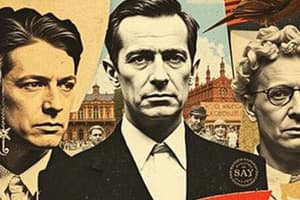Podcast
Questions and Answers
What describes the 'Selling' leadership style?
What describes the 'Selling' leadership style?
- The leader avoids decision-making altogether.
- The leader provides little direction and support.
- The leader provides both directive and supportive behavior. (correct)
- The leader focuses exclusively on task completion.
In the R1 stage of follower readiness, what is a characteristic of the followers?
In the R1 stage of follower readiness, what is a characteristic of the followers?
- Followers are able and willing.
- Followers are competent but lack motivation.
- Followers are unable and willing.
- Followers are unable and unwilling. (correct)
Which type of power is based on a leader's position in the organization?
Which type of power is based on a leader's position in the organization?
- Legitimate power (correct)
- Referent power
- Expert power
- Coercive power
What is not one of the five dimensions of trust?
What is not one of the five dimensions of trust?
What best defines 'Trust' in a leadership context?
What best defines 'Trust' in a leadership context?
What type of leaders are associated with high group productivity and higher job satisfaction?
What type of leaders are associated with high group productivity and higher job satisfaction?
What does the Least-preferred coworker (LPC) questionnaire measure?
What does the Least-preferred coworker (LPC) questionnaire measure?
In the Fiedler Model, what does 'task structure' refer to?
In the Fiedler Model, what does 'task structure' refer to?
According to Fiedler’s Situational Contingencies, what defines leader-member relations?
According to Fiedler’s Situational Contingencies, what defines leader-member relations?
What is the primary focus of Situational Leadership Theory (SLT)?
What is the primary focus of Situational Leadership Theory (SLT)?
What is the hallmark of a 'Telling' leadership style in SLT?
What is the hallmark of a 'Telling' leadership style in SLT?
Which style in the Managerial Grid is characterized by a high concern for both production and people?
Which style in the Managerial Grid is characterized by a high concern for both production and people?
Which of the following best describes the degree of position power?
Which of the following best describes the degree of position power?
What is the primary role of a leader as defined in the content?
What is the primary role of a leader as defined in the content?
Which trait is essential for leaders to build trusting relationships?
Which trait is essential for leaders to build trusting relationships?
Why is intelligence a necessary trait for leaders?
Why is intelligence a necessary trait for leaders?
Which trait indicates that a leader is determined and persistent?
Which trait indicates that a leader is determined and persistent?
What does job-relevant knowledge in leaders allow them to do?
What does job-relevant knowledge in leaders allow them to do?
Which of the following describes a characteristic related to a leader's personality?
Which of the following describes a characteristic related to a leader's personality?
What characteristic is necessary for leaders to inspire confidence in their followers?
What characteristic is necessary for leaders to inspire confidence in their followers?
How is guilt proneness related to leadership effectiveness?
How is guilt proneness related to leadership effectiveness?
The inability to consistently identify differing traits between leaders and non-leaders highlights what complexity of leadership?
The inability to consistently identify differing traits between leaders and non-leaders highlights what complexity of leadership?
Which trait is associated with leaders who can understand and respond to the needs of others?
Which trait is associated with leaders who can understand and respond to the needs of others?
What does the democratic style of leadership emphasize?
What does the democratic style of leadership emphasize?
According to behavioral theories, which leadership style was found to be the most effective in the University of Iowa studies?
According to behavioral theories, which leadership style was found to be the most effective in the University of Iowa studies?
What does the consideration dimension in the Ohio State studies involve?
What does the consideration dimension in the Ohio State studies involve?
What is a characteristic of leaders high in conscientiousness?
What is a characteristic of leaders high in conscientiousness?
What is the result of a high-high leader in the Ohio State studies?
What is the result of a high-high leader in the Ohio State studies?
What does the laissez-faire leadership style provide to the group?
What does the laissez-faire leadership style provide to the group?
Flashcards
Selling Leadership Style
Selling Leadership Style
A leadership style that combines directive and supportive behaviors.
Participating Leadership Style
Participating Leadership Style
A leadership style where the leader and followers share decision-making, facilitating and communicating.
Delegating Leadership Style
Delegating Leadership Style
A leadership style with low direction and support.
Follower Readiness Stage R1
Follower Readiness Stage R1
Signup and view all the flashcards
Expert Power
Expert Power
Signup and view all the flashcards
Leader
Leader
Signup and view all the flashcards
Leadership
Leadership
Signup and view all the flashcards
Leadership Traits Research
Leadership Traits Research
Signup and view all the flashcards
Trait research limitations
Trait research limitations
Signup and view all the flashcards
Drive
Drive
Signup and view all the flashcards
Desire to Lead
Desire to Lead
Signup and view all the flashcards
Honesty and Integrity
Honesty and Integrity
Signup and view all the flashcards
Self-Confidence
Self-Confidence
Signup and view all the flashcards
Leadership Effectiveness
Leadership Effectiveness
Signup and view all the flashcards
Guilt Proneness
Guilt Proneness
Signup and view all the flashcards
Emotional Intelligence
Emotional Intelligence
Signup and view all the flashcards
Conscientiousness
Conscientiousness
Signup and view all the flashcards
Behavioral Theories
Behavioral Theories
Signup and view all the flashcards
Democratic Leadership
Democratic Leadership
Signup and view all the flashcards
Autocratic Leadership
Autocratic Leadership
Signup and view all the flashcards
Consideration (Leadership Style)
Consideration (Leadership Style)
Signup and view all the flashcards
Employee-oriented leadership
Employee-oriented leadership
Signup and view all the flashcards
Production-oriented leadership
Production-oriented leadership
Signup and view all the flashcards
Managerial Grid
Managerial Grid
Signup and view all the flashcards
Fiedler Contingency Model
Fiedler Contingency Model
Signup and view all the flashcards
Least Preferred Coworker (LPC) Questionnaire
Least Preferred Coworker (LPC) Questionnaire
Signup and view all the flashcards
Leader-Member Relations
Leader-Member Relations
Signup and view all the flashcards
Task Structure
Task Structure
Signup and view all the flashcards
Position Power
Position Power
Signup and view all the flashcards
Study Notes
Chapter 17: Being an Effective Leader
- Who Are Leaders and What is Leadership?
- Leader: someone who can influence others and holds managerial authority.
- Leadership: a process of influencing a group to achieve goals.
Leadership Traits
- Research into personal characteristics that differentiate effective leaders from ineffective ones was unsuccessful.
- It proved impossible to identify a set of traits that always distinguish a leader from someone who isn't a leader.
Exhibit 17.1 Ten Traits Associated with Leadership
- Drive: high effort, ambition, energy, persistence, and initiative.
- Desire to lead: strong desire to influence and lead others, willingness to take responsibility.
- Honesty and integrity: building trust through truthfulness, non-deceitfulness, and consistency between words and actions.
- Self-confidence: showing self-confidence to followers to build trust in their goals and decisions.
- Intelligence: ability to gather, synthesize, interpret information, create visions, and solve problems.
- Job-relevant knowledge: in-depth knowledge of the company, industry, and technical matters to make informed decisions.
- Extraversion: being energetic, lively, sociable, assertive, and rarely withdrawn.
- Proneness to guilt: strong sense of responsibility for others, positively related to leadership effectiveness.
- Emotional Intelligence: empathetic – sensing others' needs, listening to followers, and understanding reactions.
- Conscientiousness: disciplined and able to keep commitments, which is beneficial for leadership.
Leadership Behaviors
- Behavioral theories: identify behaviors that differentiate effective leaders.
Exhibit 17.2 Behavioral Theories of Leadership
- University of Iowa: Styles include democratic (involving subordinates), autocratic (dictating methods), and laissez-faire (giving group freedom).
- Ohio State: Focused on consideration (being considerate of followers) and initiating structure (structuring work to meet goals).
- University of Michigan: Studied employee-oriented (interpersonal relationships) and production-oriented (technical aspects).
- Managerial Grid: Emphasizes concern for people (1-9) and concern for production (1-9). High-high (9,9) style with high concern for both production and people is often best.
The Fiedler Model
- Fiedler contingency model: effective group performance depends on matching a leader's style with the situation.
- Least-preferred coworker (LPC) questionnaire: measures if a leader is task-oriented or relationship-oriented.
- Fiedler's situational contingencies:
- Leader-member relations: degree of trust and respect employees have.
- Task structure: degree of job formalization.
- Position power: influence over activities like hiring and firing.
Exhibit 17.3 The Fiedler Model
- Performance graph showing how leader styles align with favorable versus unfavorable situations.
Hersey and Blanchard's Situational Leadership Theory
- Situational leadership theory (SLT) is a contingency theory focused on followers' readiness.
- Readiness: extent to which people have ability and willingness to accomplish a task.
SLT Leadership Styles
- Telling: high task/low relationship (leader defines roles).
- Selling: high task/high relationship (leader provides directive and supportive behavior).
- Participating: low task/high relationship (leader and followers share decisions).
- Delegating: low task/low relationship (leader provides little direction).
Four Stages of Follower Readiness
- R1: followers are unable and unwilling (incompetent and unconfident).
- R2: followers are unable but willing (unskilled but motivated).
- R3: followers are able but unwilling (competent but don't want to participate).
- R4: followers are able and willing (competent and motivated).
Managing Power
- Legitimate power: power from position within organization.
- Coercive power: power to punish or control.
- Reward power: power to give positive rewards.
- Expert power: power from expertise, skills, or knowledge.
- Referent power: power from desirable resources or personal traits.
Developing Trust
- Credibility: degree followers perceive someone as honest, competent, and inspirational.
- Trust: belief in a leader's integrity, character, and ability.
- Five Dimensions of Trust:
- Integrity: honesty and truthfulness.
- Competence: technical and interpersonal skills.
- Consistency: reliability and good judgment.
- Loyalty: willingness to protect others.
- Openness: willingness to share ideas.
Studying That Suits You
Use AI to generate personalized quizzes and flashcards to suit your learning preferences.
Related Documents
Description
This quiz focuses on Chapter 17, which explores the concepts of leadership and the characteristics that define effective leaders. Learn about the essential traits of leaders, such as drive, integrity, and self-confidence, and understand their impact on influencing others and achieving goals.




